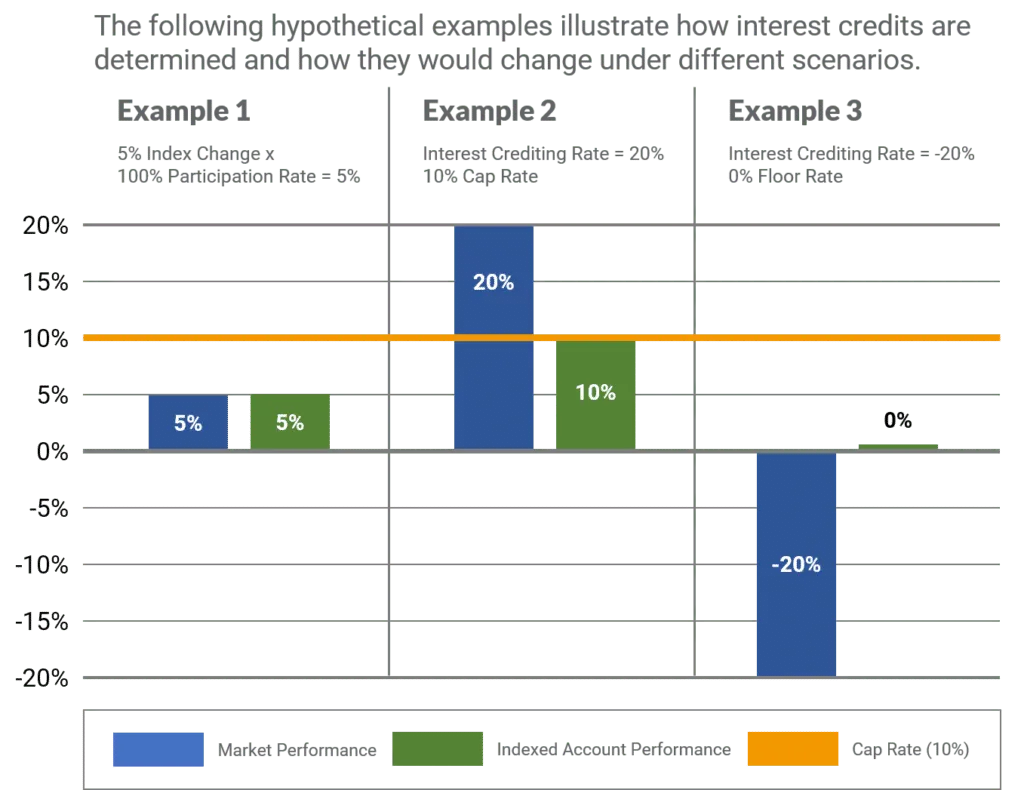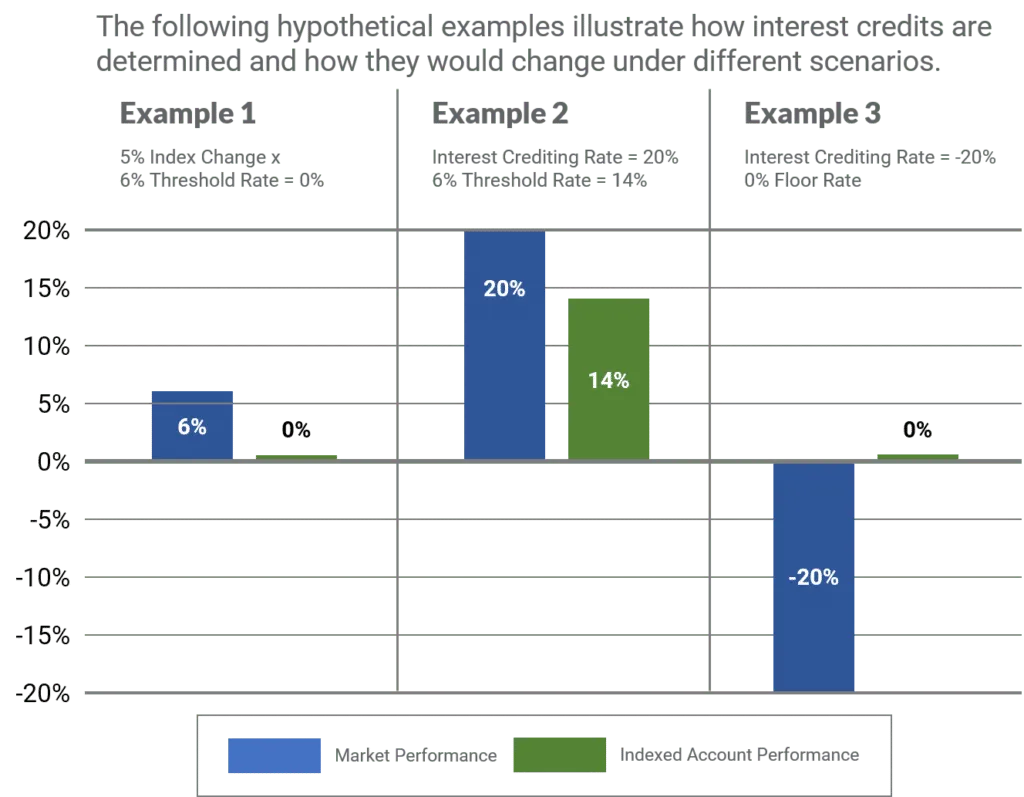The Power of Indexing
The indexing strategy is a novel approach to helping grow and protect your wealth simultaneously. When harnessing the Power of Indexing, funds contributed to certain vehicles are able to capture upward growth in the market, but those same funds are completely shielded from any loss in the market.

How It Works
When funds are added to vehicles that leverage the indexing strategy, those funds are invested directly in the stock market. Instead, the owner selects one or more market indexes (i.e. S&P 500, NASDAQ, Dow Jones, etc.) that they would like their funds to follow.
Once these indexes have been selected, they are followed for a particular period of time (generally annually) to track their movement. If an index has increased in value during that time, a portion of that growth is attributed to your account. However, if an index decreases in value during that time, the account is credited zero dollars, meaning no money is lost - zero is your hero! Contributed funds are therefore insulated from future loss.
In other words, your funds are either growing or holding steady, but are never going down due to market volatility.
How Growth Is Captured Using Indexing
It may seem to good to be true that you can have all of the growth in the market in addition to complete protection from loss, and in most cases, it is. There are different crediting methods that may limit the growth captured by the indexing strategy, but in certain situations, they can actually increase the growth. The 3 main methods utilize caps, spreads and participation rates.

Caps
Crediting methods using caps tend to be the most commonly used. The cap determines the maximum percentage that the funds can grow during the crediting period. If the index grows but does not exceed the cap, the entire growth of the index is credited to the account. However, if the growth during the crediting period exceeds the cap, the account will only receive the growth up to the cap.
In the chart, the cap is set at 10%. In Example 1, the market index increases by 5%, so the account is credited the entire 5%. In Example 2, the market index increases by 20%, so the account is only credit by 10%, which is where the cap is set.

Spreads
Crediting methods using spreads (sometimes called thresholds or margins) are not as common as those using caps, but can add important diversity to your overall crediting lineup. The reason is that these strategies do not have any caps, so they allow greater growth to be captured when a market index performs very well.
The spread refers to a threshold set during the crediting period that must be overcome before the funds are credited with any growth. Once that threshold has been exceeded, there is no limit to how much the funds can grow during that crediting period. However, if the growth during the crediting period does not exceed the spread, the account will be credited with zero growth.
In the chart, the spread is set at 6%. In Example 1, the market index increases by 5%, which does not exceed the spread, so the account is credited with zero growth. In Example 2, the market index increases by 20%, so the account is credited by 14% since the spread has been exceeded (20% - 6%).

Participation Rates
Crediting methods using participation rates multiply the actual growth of the market index by a particular percentage; that percentage is known is the participation rate. The previous strategies were designed to potentially limit the growth captured during the crediting period. Although participation rates can be less than 100% (i.e. 80%), participation rates are often greater than 100% (i.e. 150%), allowing the allocated funds to grow more than the actual market index does.
In the chart, the participation rate is set to 110%. In Example 1, the market index increases by 26%, so the account is credited with 28.6% (26% x 110%). In Example 2, the market index increases by 80%, so the account is credited by 88% (80% x 110%).
Note that with each of these crediting methods, Example 3 of the chart shows that the market index fell by 20% during the crediting period. Since all of these methods fall under the umbrella of the indexing strategy, the "floor" is set at zero and the funds lose no money at all.
Which Vehicles Use the Indexing Strategy?
The indexing strategy is not common to many financial vehicles. The two vehicles that employ this strategy are the Indexed Universal Life insurance policy (or IUL) and the Fixed Index Annuity (or FIA). Although both vehicles leverage the Power of Indexing, they have important unique characteristics that allow each of them to enhance your retirement journey in different ways.
To learn more about the core benefits of an IUL, watch the following video and click below:
If you would like to see how the indexing strategy can work specifically for you, click below to schedule a free consultation with us. It would be our pleasure to serve you in your journey towards financial security and peace of mind.
FAQS
What services do you offer?
We offer a comprehensive range of financial services tailored to your unique needs. Our services include life insurance analysis, financial planning, investment management, retirement planning, estate planning, budgeting assistance and debt management. We work closely with you to create a customized financial strategy that aligns with your goals, priorities and aspirations.
How do you charge for your services?
We believe in transparency when it comes to our compensation. We are primarily paid by commission for the products we offer our clients. These products are integral to the personalized strategies we develop to help them achieve financial security. However, these products have no management fees, so no portion of the growth within these products comes back to us; it all stays with you.
We charge flat fees for specific services such as budgeting assistance and debt management. We discuss all these fees with you upfront, so there are no surprises.
How can I get started with your services?
Getting started is easy! Simply reach out to our team through the contact form on this website, email us or give us a call. You can also schedule a free initial consultation with us where we can get to know you and your financial goals better. This consultation is an opportunity for you to ask questions and learn more about how our services can benefit you. If you decide to move forward, we'll work together to create a personalized financial plan to set you on the path to financial success.
And as a way of saying "thank you" for your time and consideration, anyone who attends their scheduled consultation appointment with us will receive a $100 dollar hotel savings card, regardless of whether or not you choose to move forward with our services.
**The information provided on this website does not constitute financial advice. Consult with a qualified financial advisor before making any financial decisions based on the information provided here.

